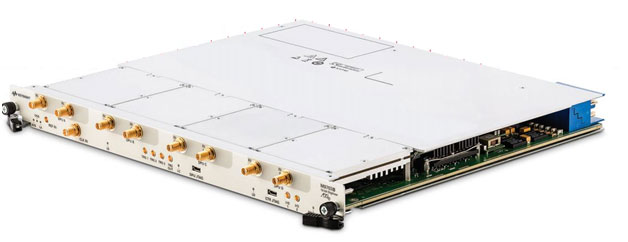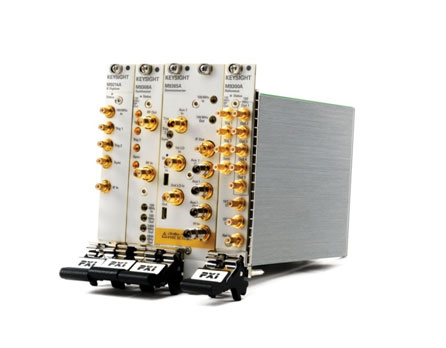Modular instruments are ideal for multi-instrument and multi-channel applications where multiple instruments are combined into a single chassis to deliver a compact solution that takes up less floor space. While benchtop instruments are generally less expensive as a stand-alone item, modular solutions are less expensive when multiple instruments are combined into a single chassis since overhead costs can be spread across several instruments. Modular instruments are typically used in design validation or manufacturing due to their smaller footprint, high speed, and lower cost; but can also be used in R&D in the design of multichannel or MIMO (multiple input, multiple output) devices.
As the number of desired channels in a test system increase, design and test become more complicated requiring better channel-to-channel correlation and additional equipment to address multiple channels. PXI and AXIe modular instruments are ideally suited for high channel count applications due to their easily integrated instrument architectures, small form factor, scalability, and module-to-module synchronization. Module-to-module synchronization, in particular, provides advanced measurement capabilities for more challenging multi-channel applications. The compact and scalable configuration of PXI allows engineers to build the test system they need today and add modules for more channels or instruments as their test system requirements change in the future.
Synchronization of multiple instruments can be a challenge. Multi-channel applications require very tight instrument-to-instrument skew which can be more readily achieved across a common backplane. The PXIe and AXIe modular architectures promote peer-to-peer interaction including data transfers and triggering through the PCIe backplane.
Modular instruments, such as PXI and AXIe, are becoming more widely used in test systems for several reasons. PXI and AXIe platforms address the engineers’ demand for greater measurement speed, including data transfers and synchronization across instrument modules. PXI is able to provide more functionality, stimulus input and measurement outputs, with more channels in a smaller form factor than benchtop instruments.
What Modular features
Multi-channel ,multi-instruments test needs are driving the modular instrumentation. Some of the prominent features of modular instruments are :
– Flexibility , upgradeability & scalability,
– Compact form factor,
– Mix-n-match (multiple-instruments, multi-vendor)
– High throughput,
– Phase, Time Coherency,
– Faster access to newer technology.
Modular is productive
High volume device test in manufacturing benefits from the use of modular instruments programmed for automatic measurement sequences where stimulus can be adjusted and results monitored through software. Multiple devices may be tested simultaneously and are best addressed by a modular system with a greater number of stimulus and measurement channels. Measurement data from multiple channels or devices can be quickly transferred and synchronized through a single, high speed modular backplane resulting in shorter test times and lowering manufacturing test costs. Phase coherency for complex applications, such as beamforming test can be easily accommodated with appropriate triggers and methods. The space and power requirements for multiple modular instruments are much less than the equivalent benchtop instrument configuration. Modular multi-channel test systems do not carry redundant, multiple displays and power supplies. This makes modular easier to accommodate in a production environment.
Wireless Testing with Modular
Some of the applications where new technology and increasing test cost are driving test engineers to seek the advantages of modular test systems are 5G and radar design/manufacturing.
Increase in mobile platforms, need of connectivity, higher data rates, efficient networks are driving newer wireless technologies. While 5G is very much in the news nowadays , it still is in chasm wherein some of the companies are working on the designs and would take at least couple of years for the technology to become mature and deployable. Some of the components of 5G like MIMO antenna architecture uses multiple transmitters and receivers all working in coherent nature. Modular test platforms brings in unique advantage in such scenarios as we can configure multiple generators and analyzers in compact form factor and can achieve tight phase coherency. Likewise the tight integration with software simulation tools (for eg. Keysight SystemVue) and analysis tools (Keysight VSA) provides lot of insights during early stage designs.
Similarly in Aerospace / Defense community, we are witnessing a major shift across all technologies. Major example is RADAR wherein the industry is moving from passive , single element RADAR to active, electronically steerable , multiple elements RADARS (AESA). Again the need for multi-channel, phase coherent test platforms brings in modular instrumentation which offers incredible flexibility with open options for integrating many instruments and software.
Keysight offers a wide range of modular instruments in various form factors as USB, PXIe, AXIe. With its strong 75years of test & measurement heritage, we are bringing the same level of innovation and measurement confidence in our modular range of products. With so many choices and combinations of products it may be overwhelming for test engineers to select and verify the performance of combined modules and software. Keysight also provides Reference Solutions – a proven recipe of hardware and software configurations for specific applications. The market-validated recipe optimizes the use of precision modular products, benchtop products and software for applications such as power amplifier test, LTE-A multi-channel CA/MIMO, phased array antenna test, milcom and public safety radio test, and satellite signal monitoring. The primary advantage of the Reference Solutions is the time saved in selecting and integrating products. As new test systems are added or created the Reference Solution could help engineers meet stringent schedules and test requirements by providing high performance test configurations
Keysight modular platforms
Some of our key modular platforms are as listed below.
M9703B AXIe 12-bit High-Speed Digitizer/Wideband Digital Receiver

– 8 channels (4 when interleaving) with 12-bit resolution
– Up to 3.2 GS/s sampling rate
– DC to 2 GHz input frequency range
– Up to 16 GB (1 Samples/ch) on-board memory
– 4 configurable Virtex-6 FPGAs
– Digital down conversion with streaming and recording bundles
2.) M9393A PXIe Performance Vector Signal Analyzer: 50 GHz

– Fastest, most accurate microwave signal analysis in PXI
- Frequency range: 9 kHz to 8.4, 14, 18, 27 , 50 GHz
- Wideband IF output: up to 800 MHz
- Frequency switching speed: 135 us
- Amplitude accuracy: ± .13 dB, typ @ 1 GHz
– Future-ready extensible, upgradable hardware
- Fit up to 4 channels in a chassis time-synchronized to < 1 ns
– Consistent, proven results with 89600 VSA software and X-Series applications
Author Profile
 Mr. Sadaf Siddiqui, Business Development Manager, Keysight Technologies India Pvt. Ltd.
Mr. Sadaf Siddiqui, Business Development Manager, Keysight Technologies India Pvt. Ltd.






